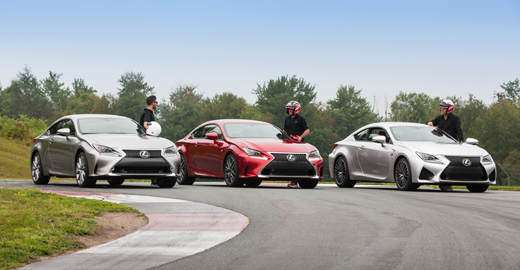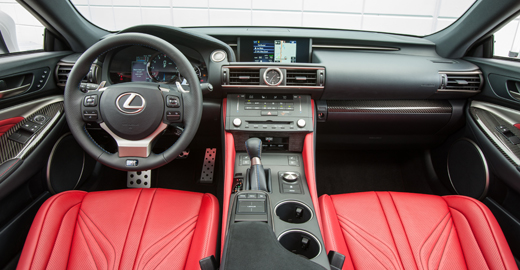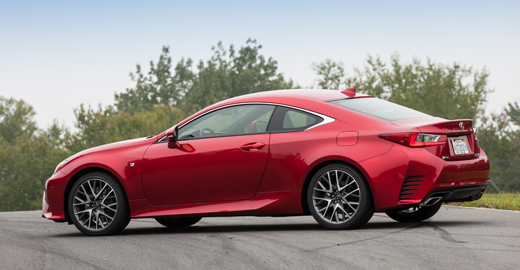Lexus executives have been reading from the same playbook for the last three years. When the fourth-generation GS was launched in 2012, all of the talk was about bringing more emotion to the brand, through dramatic styling and a more dynamic attitude.
When the third-generation IS was launched in 2013, the talk was still about bringing more emotion to the brand.
Last week, the RC coupe was launched to the international motoring media in New York. In case you were wondering, this car is intended to bring more emotion to the brand.
Too much more emotion and somebody's going to have a breakdown.
But still, if Toyota's luxury brand has been trying to lead us somewhere over the last three years, we've probably arrived with this car. A sporting coupe makes more of a statement than a luxury sedan. It also comes under much more scrutiny, because it's an indulgent and very personal choice for potential buyers.
A coupe has to deliver on styling, performance, styling, handling and styling.
Lexus has taken no chances with the RC. It's waited until the striking and sometimes controversial L-Finesse design template is well-established on a suite of other models, before turning it up a notch on the RC. It hasn't based the coupe on any other single Lexus model: the platform borrows from the GS (front), previous IS convertible (middle) and current IS sedan (rear). The body panels and interior architecture are bespoke.

Lexus RC line-up
Hero status is also ensured for the RC because it's also the latest vehicle for the F-brand: the Lexus answer to Audi RS, BMW M and Mercedes-AMG. Indeed, the flagship Lexus RC-F is only the third production model from the F division. The first was the IS-F (2007). The second was the LFA supercar (2010). Good company. The RC-F will head a three-tier RC model range in New Zealand from early 2015. Lexus New Zealand is dispensing with anything you think of as entry-level: the range will open with the RC 350 F Sport, with the RC 350 Limited as a more luxurious alternative. The RC-F will be making all of the noise at the head of the class.
The RC fits in between the IS and GS ranges in terms of size and presumably price, although the latter is yet to be confirmed. Prime targets for the range include the Audi S5, BMW 4 Series and forthcoming Mercedes-Benz C-Class coupe.
Lexus New Zealand has little to say on price at this stage, but the competitive set would put the RC 350 range somewhere between $100,000 and $120,000, while the RC-F is likely to be further up into $150,000 territory.
You could not accuse Lexus of lacking attention to detail. Each of the three variants have distinct styling: the Limited has a unique grille and a simpler body shape, while the F Sport and RC-F have their own (but different for each) body kits. The RC-F has some unique body panels, including pumped-up front wings and a bootlid that carries an active spoiler. You can also order a carbon-fibre styling package for the RC-F that gives you an unpainted roof, rear spoiler and even bonnet if you want it. Each of the RC trio have individual instrument panels and even different front-seat designs.

The RC 350 models use the same 3.5-litre V6 engine as the IS 350 and GS 350. The powerplant makes 233kW/378Nm and is matched to an eight-speed automatic gearbox.
The F Sport model also comes with a suite of technical features aimed at making it more nimble and engaging to drive: variable ratio steering, adaptive suspension, rear-wheel steering and a four-tier Drive Mode Select system, which can calibrate the car in Eco, Normal, Sport and Sport Plus settings.
The Limited does without the trick driver-assistance features and only has a three-mode Drive Select system, but will come as standard with a more comprehensive list of comfort and convenience items.
The volume goes up again with the RC-F, which has a heavily updated version of the previous IS-F's 5.0-litre V8 engine. Lexus has extracted another 40kW in the process, with peak outputs of 351kW/550Nm. It's an intriguing engine and not just because it makes muscle-car noises: at low speeds it runs in the Atkinson cycle, just like the petrol engine in a Toyota Prius hybrid. This saves fuel and allows it to return 10.9 litres in the Combined cycle, which compares very well to the RC 350's 9.4 litres.
However, Atkinson-cycle engines are not known for their crisp throttle response, so as soon as you become aggressive with the loud-pedal it switches into the conventional Otto cycle. "Loud pedal" is perhaps an appropriate phrase, because beyond 3000rpm a resonator under the dashboard wakes up and doubles the volume of V8 noise in the cabin.

Lexus 350 F Sport
The RC-F has its own styling of course, but much of what lies beneath is calibrated especially for this car: 70 per cent of the suspension is unique to the RC-F. It doesn't have rear-steer like the F Sport, but it does have an old-school limited-slip differential. An option is a torque vectoring system, which can actively send more power to the outside-rear wheel to increase cornering speed and stability (you can adjust how aggressive it gets).
Much of the media drive took place at the exclusive Monticello Motor Club in upstate New York, a private circuit that's usually only open to members who pay their $125,000 a year. People like Jerry Seinfeld; although he's more of an Acura NSX man.
While a Monticello-level gentleman racer might be quick to dismiss the cheapest RC, the F Sport certainly held its own on the track. It's brisk enough (0-100km/h in 6.3 seconds), the V6 engine provides impressively linear performance and the enhanced steering and suspension package makes it a nimble machine indeed. Really, it's only the level of body roll that reminds you of this car's limits.
The RC-F is supposed to be a comfortable road car too - and it is - but let's not forget that the F stands for Fuji Speedway and cars from this division are intended to be track-ready. The RC-F is all sound and fury, although ultimately it's also a less forgiving machine than the F Sport. The performance is in another league (0-100km/h 4.4 seconds, 270km/h) of course, but you have to work hard to keep the car in the zone: peak torque is not reached until 4800rpm.
The RC-F chassis is capable of amazing things, especially with the torque-vectoring differential fitted. But it can also be tricky compared with the F Sport: the RC-F is 100kg heavier and more subject to weight transfer if your cornering is clumsy.
Perhaps that's exactly as it should be: the mainstream model sets out to flatter you at every turn, whereas the specialised one can flatten your ego if you get things wrong. Either way, there's an impressive range of emotion on display.


